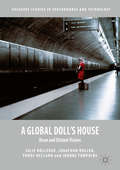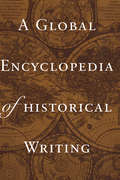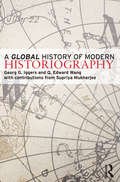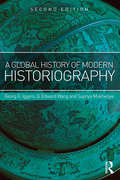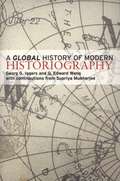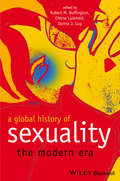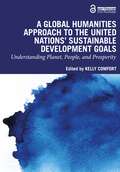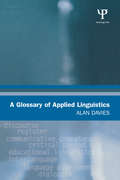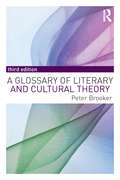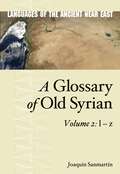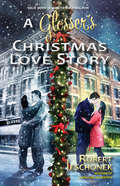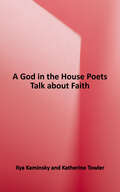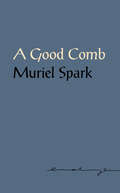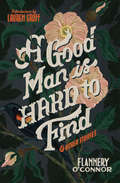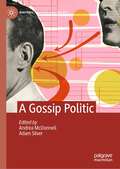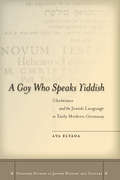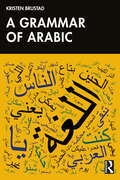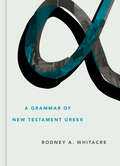- Table View
- List View
A Global Doll's House: Ibsen and Distant Visions (Palgrave Studies in Performance and Technology)
by Julie Holledge Jonathan Bollen Frode Helland Joanne TompkinsThis book addresses a deceptively simple question: what accounts for the global success of A Doll's House, Henrik Ibsen's most popular play? Using maps, networks, and images to explore the world history of the play's production, this question is considered from two angles: cultural transmission and adaptation. Analysing the play's transmission reveals the social, economic, and political forces that have secured its place in the canon of world drama; a comparative study of the play's 135-year production history across five continents offers new insights into theatrical adaptation. Key areas of research include the global tours of nineteenth-century actress-managers, Norway's soft diplomacy in promoting gender equality, representations of the female performing body, and the sexual vectors of social change in theatre.
A Global Encyclopedia of Historical Writing, Volume 2
by D. R. WoolfFirst published in 1998. Including a wide range of information and recommended for academic libraries, this encyclopedia covers historiography and historians from around the world and will be a useful reference to students, researchers, scholars, librarians and the general public who are interested in the writing of history. Volume II covers entries from K to Z.
A Global History of Modern Historiography
by Q. Edward Wang Supriya Mukherjee Georg G IggersSo far histories of historiography have concentrated almost exclusively on the West. This is the first book to offer a history of modern historiography from a global perspective. Tracing the transformation of historical writings over the past two and half centuries, the book portrays the transformation of historical writings under the effect of professionalization, which served as a model not only for Western but also for much of non-Western historical studies. At the same time it critically examines the reactions in post-modern and post-colonial thought to established conceptions of scientific historiography. A main theme of the book is how historians in the non-Western world not only adopted or adapted Western ideas, but also explored different approaches rooted in their own cultures.
A Global History of Modern Historiography
by Q. Edward Wang Supriya Mukherjee Georg G IggersThe first book on historiography to adopt a global and comparative perspective on the topic, A Global History of Modern Historiography looks not just at developments in the West but also at the other great historiographical traditions in Asia, the Middle East, and elsewhere around the world over the course of the past two and a half centuries. This second edition contains fully updated sections on Latin American and African historiography, discussion of the development of global history, environmental history, and feminist and gender history in recent years, and new coverage of Russian historical practices. Beginning in the mid-eighteenth century, the authors analyse historical currents in a changing political, social and cultural context, examining both the adaptation and modification of the Western influence on historiography and how societies outside Europe and America found their own ways in the face of modernization and globalization. Supported by online resources including a selection of excerpts from key historiographical texts, this book offers an up-to-date account of the status of historical writing in the global era and is essential reading for all students of modern historiography.
A Global History of Modern Historiography
by Georg G. Iggers Q. Edward Wang Supriya MukherjeeA critical survey of historical thought and writing since the late eighteenth century from an intercultural, comparative global perspective. A comprehensive overview of historical thought and writing in the modern period. The first history of modern historiography which deals with the interaction of Western and non-Western historical thought. Sets historiography into its social, political and cultural context.
A Global History of Modern Historiography
by Q. Edward Wang Supriya Mukherjee Georg IggersThe first book on historiography to adopt a global and comparative perspective on the topic, A Global History of Modern Historiography looks not just at developments in the West but also at the other great historiographical traditions in Asia, the Middle East, and elsewhere around the world over the course of the past two and a half centuries. This second edition contains fully updated sections on Latin American and African historiography, discussion of the development of global history, environmental history, and feminist and gender history in recent years, and new coverage of Russian historical practices. Beginning in the mid-eighteenth century, the authors analyse historical currents in a changing political, social and cultural context, examining both the adaptation and modification of the Western influence on historiography and how societies outside Europe and America found their own ways in the face of modernization and globalization.Supported by online resources including a selection of excerpts from key historiographical texts, this book offers an up-to-date account of the status of historical writing in the global era and is essential reading for all students of modern historiography.
A Global History of Sexuality: The Modern Era
by Donna J. Guy Robert M. Buffington Eithne LuibhéidA Global History of Sexuality provides a provocative, wide-ranging introduction to the history of sexuality from the late eighteenth century to the present day. Explores what sexuality has meant in the everyday lives of individuals over the last 200 years Organized around four major themes: the formation of sexual identity, the regulation of sexuality by societal norms, the regulation of sexuality by institutions, and the intersection of sexuality with globalization Examines the topic from a comparative, global perspective, with well-chosen case studies to illuminate the broader themes Includes interdisciplinary contributions from prominent historians, sociologists, anthropologists, and sexuality studies scholars Introduces important theoretical concepts in a clear, accessible way
A Global Humanities Approach to the United Nations' Sustainable Development Goals: Understanding Planet, People, and Prosperity
by Kelly ComfortThis edited textbook explores the 17 UN SDGs through 12 works from the humanities, including films, novels, and photographic collections. It provides students with the knowledge and understanding of how the humanities engage in broader social, political, economic, and environmental dialogue, offering a global perspective that crosses national and continental borders. The book takes students through the UN SDGs from a theoretical perspective through to practical applications, first through specific global humanities examples and then through students’ own final projects and reflections. Centered around three major themes of planet, people, and prosperity, the textbook encourages students to explore and apply the Goals using a place-based, culturally rooted approach while simultaneously acknowledging and understanding their global importance. The text’s examples range from documentary and feature film to photography and literature, including Wang Jiuliang’s Plastic China, Kip Andersen and Keegan Kuhn’s Cowspiracy: The Sustainability Secret, Barbara Dombrowski’s Tropic Ice: Dialog Between Places Affected by Climate Change, and Aravind Adiga’s The White Tiger, among others. Providing diverse geographic and cultural perspectives, the works take readers to Argentina, Australia, China, Costa Rica, Ecuador, France, Greenland, Haiti, India, Japan, Peru, Rwanda, Senegal, and the United States. This broad textbook can be used by students and instructors at undergraduate and postgraduate levels from any subject background, particularly, but not exclusively, those in the humanities. With added discussion questions, research assignments, writing prompts, and creative project ideas, students will gain a nuanced understanding of the interconnectivity between social, cultural, ethical, political, economic, and environmental factors.
A Global Standard for Reporting Conflict (Routledge Research in Journalism)
by Jake LynchA Global Standard for Reporting Conflict constructs an argument from first principles to identify what constitutes good journalism. It explores and synthesises key concepts from political and communication theory to delineate the role of journalism in public spheres. And it shows how these concepts relate to ideas from peace research, in the form of Peace Journalism. Thinkers whose contributions are examined along the way include Michel Foucault, Johan Galtung, John Paul Lederach, Edward Herman and Noam Chomsky, Manuel Castells and Jurgen Habermas. The book argues for a critical realist approach, considering critiques of ‘correspondence’ theories of representation to propose an innovative conceptualisation of journalistic epistemology in which ‘social truths’ can be identified as the basis for the journalistic remit of factual reporting. If the world cannot be accessed as it is, then it can be assembled as agreed – so long as consensus on important meanings is kept under constant review. These propositions are tested by extensive fieldwork in four countries: Australia, the Philippines, South Africa and Mexico.
A Glossary of Applied Linguistics
by Alan DaviesApplied Linguistics is still a growing field. Key texts and handbooks have appeared in recent years and international applied linguistics conferences and professional associations occur regularly. While Applied Linguistics continues to attract new entrants and to generate new strands of research, there is a need for a clear and concise map of the field. This is the purpose of the Glossary.The author, Alan Davies, is a well-established, well-published authority on applied linguistics. Not a typically dry dictionary, Dr. Davies infuses the alphabetical entries with a touch of humor and thought-provoking context creating an up-to-date, useful, and coherent view of applied linguistics.The Glossary compiles the most ubiquitously used terms in applied linguistics and teacher-training literature. It takes a wide-ranging view of the field, drawing not only on linguistics but including psychology, sociology, education, measurement theory, speech therapy, translation, and language planning. Other features include:*numerous cross-references to key terms;*an introduction, which discusses the difficulty of defining applied linguistics; and*a brief reading list of key text.The primary market is master's student in Applied Linguistics, Second Language Acquisition, and TESL/TEFL. Undergraduate students, particularly in language fields and in education will also find it helpful, as well as language teachers who have not themselves followed Applied Linguistics courses and who are interested in finding out about the field.
A Glossary of Literary Terms
by M. H. Abrams Geoffrey Galt HarphamThis book defines and discusses terms, critical theories, and points of view that are commonly applied in classifying, analyzing, interpreting, and writing the history of works of literature. The component entries, together with the guides to further reading included in most of them, are oriented especially toward undergraduate students of English, American, and other literatures. Over the decades, however, the book has proved to be a useful and popular work of reference for advanced students, as well as for the general reader with literary interests.
A Glossary of Literary and Cultural Theory
by Peter BrookerThe Glossary of Literary and Cultural Theory provides researchers and students with an up-to-date guide through the vibrant and changing debates in Literary and Cultural Studies. In a field where meanings are frequently complex and ambiguous, this text is remarkable for its clarity and usefulness. This third edition includes 17 entirely new entries and updates to more than a dozen others which address key concepts and contemporary positions in both literary and cultural theory. New entries include: • Actor Network Theory • Anthropocene • Ecocriticism • Digital Humanities • Postcapitalism • World Literature
A Glossary of Old Syrian: Volume 1: ʔ – ḳ (Languages of the Ancient Near East)
by Joaquin SanmartínA Glossary of Old Syrian: ʔ – ḳ is the first of two volumes aimed at the completion of a lexicographical index of the Old Syrian linguistical continuum. This glossary gives a picture, or map, of the Old Syrian lexicon as it can be extracted and reconstructed from the available sources, from the (Old Akkadian-)Eblatic through the Old and Middle Babylonian corpora.Old Syrian can be defined most appropriately as a diachronically conservative, geographically pluricentric, and pragmatically multilayered linguistic cluster. Therefore, the present work pays special attention to the distribution of lexical data along diatopic and diastratic criteria. In view of the enormous amount of material and the dispersion of the data, this glossary focuses on the most representative textual corpora of the Old Syrian linguistic landscape. The bibliographical references are kept deliberately succinct and as a rule, restricted to the classic works that may be easily found in every Assyriological or Semitic library, public or private, and that will redirect the users to their sources. Since the Old Syrian lexicography remains uncertain, the leading interpretative opinions are included alongside the most relevant comparative Semitic material. A Glossary of Old Syrian offers a clear picture of the current state of this field and is intended to serve as a reference work in support of future study.
A Glossary of Old Syrian: Volume 2: l – z (Languages of the Ancient Near East)
by Joaquin SanmartínA Glossary of Old Syrian: l–z is the second of two volumes that aim to map the lexicon of Old Syrian as it can be extracted and reconstructed from the (Old Akkadian) Eblaite through the Old and Middle Babylonian corpora.Referring to a continuum of dialects spoken in the Syrian-Levantine and Syrian-Mesopotamian regions through the third and second millennia BCE, “Old Syrian” is a diachronically conservative, geographically pluricentric, and pragmatically multilayered linguistic cluster. As such, the Glossary pays special attention to the distribution of lexical data along diachronic, diatopic, and diastratic criteria. Given the extent and widely dispersed nature of this data, entries are supported by the most representative corpora of the Old Syrian linguistic landscape. Each entry is headed by an etymon, a kind of prelinguistic consonantal skeleton, and further information about different lexemes, their roots, and their derivations is provided in subentries. As the lexicography of Old Syrian remains uncertain, the Glossary includes leading interpretative opinions alongside the most relevant Semitic material to corroborate the lexical choices it adopts. Bibliographical references are succinct and restricted, as a rule, to texts easily found in any Assyriological or Semitic library.Intended as a reference work in support of future study, A Glossary of Old Syrian offers a clear view of the state of the field.
A Glosser's Christmas Love Story
by Robert Jeschonek Ben BaldwinWith her fiancé far away fighting a war in Korea, Sarah faces a blue Christmas in Johnstown, Pennsylvania in 1953. But going to work as an elf at Glosser’s Department Store turns her holiday upside-down. Santa Claus, played by fellow employee Frank, falls beard over sleighbells for her. When the magic of the season at Glosser’s lights a spark of romance between them, Sarah is torn between the man at war and the one in the St. Nick outfit. On the night before Christmas, she must make a fateful choice that changes everything...and leads her to a crossroads 63 years later at the famous musical Christmas tree in Johnstown’s Central Park. Don't miss this sweet holiday romance by the author of LONG LIVE GLOSSER'S and PENN TRAFFIC FOREVER.
A God in the House: Poets Talk about Faith
by Ilya Kaminsky Katherine TowlerLiterary Nonfiction. Poetry. Editors Ilya Kaminsky and Katherine Towler have gathered conversations with nineteen of America's leading poets, reflecting upon their diverse experiences with spirituality and the craft of writing. Bringing together poets who are Christian, Buddhist, Jewish, Muslim, Pagan, Native American, Wiccan, agnostic, and otherwise, this book offers frank and thoughtful consideration of themes too often polarized and politicized in our society. Participants include Li-Young Lee, Jane Hirshfield, Carolyn Forché, Gerald Stern, Christian Wiman, Joy Harjo, and Gregory Orr, and others, all wrestling with difficult questions of human existence and the sources of art.
A Good Cause (Reach Into Phonics Ser.)
by Nonie K. Lesaux National Geographic Learning Sylvia Linan ThompsonNIMAC-sourced textbook
A Good Comb: The Sayings of Muriel Spark
by Muriel SparkCelebrate the immortal Muriel Spark’s hundredth birthday by imbibing a delicious glass of her bubbly wit A Good Comb, a small gift edition of Muriel Spark’s brilliant asides, sayings, and aphorisms, is a book for sheer enjoyment. No writer offers such lively, pointed, puckish insights: “Neurotics are awfully quick to notice other people’s mentalities.” “It is impossible to persuade a man who does not disagree, but smiles.” “The sacrifice of pleasure is of course itself a pleasure.” “It is impossible to repent of love. The sin of love does not exist.” “She wasn’t a person to whom things happen.” “You look for one thing and you find another.” “It calms you down, a good comb.” Her scope is great and her striking insights are precise and unforgettable. This book will entertain you—it will even help you live your life. Drink in the pleasures of this little volume along with the benefits of taking up such advice as “Never make excuses but if you must, never make more than one—it gives the appearance of insincerity.” And “Beware of men bearing flowers.”
A Good Man Is Hard to Find and Other Stories: And Other Stories
by Flannery O'ConnorThe collection that established O'Connor's reputation as one of the american masters of the short story. <P><P>The volume contains the celebrated title story, a tale of the murderous fugitive The Misfit, as well as "The Displaced Person" and eight other stories.
A Gossip Politic (Rhetoric, Politics and Society)
by Adam Silver Andrea McDonnellThis book makes explicit the historical, technological, and discursive links between gossip as a mode of communication, news media, and contemporary politics. A Gossip Politic advances a new framework of gossip, applying the informal understanding of the term to news talk and political actors. Authored by esteemed scholars in the fields of Political Science, Media Studies, Linguistics, and Sociology, chapters consider the influence of gossip on the press, the American presidency, and the public. A Gossip Politic provides readers with a multi-faceted portrait of the ways in which gossip has influenced media history, shaped our understanding of democracy, and contributed to our current political landscape.
A Goy Who Speaks Yiddish: Christians and the Jewish Language in Early Modern Germany
by Aya ElyadaThis book explores the unique phenomenon of Christian engagement with Yiddish language and literature from the beginning of the sixteenth century to the late eighteenth century. By exploring the motivations for Christian interest in Yiddish, and the differing ways in which Yiddish was discussed and treated in Christian texts,A Goy Who Speaks Yiddishaddresses a wide array of issues, most notably Christian Hebraism, Protestant theology, early modern Yiddish culture, and the social and cultural history of language in early modern Europe. Elyada's analysis of a wide range of philological and theological works, as well as textbooks, dictionaries, ethnographical writings, and translations, demonstrates that Christian Yiddishism had implications beyond its purely linguistic and philological dimensions. Indeed, Christian texts on Yiddish reveal not only the ways in which Christians perceived and defined Jews and Judaism, but also, in a contrasting vein, how they viewed their own language, religion, and culture.
A Grammar Of Tariana, From Northwest Amazonia
by Alexandra Y. AikhenvaldThis is a comprehensive reference grammar of Tariana, an endangered Arawak language from a remote region in the northwest Amazonian jungle. Its speakers traditionally marry someone speaking a different language, and as a result most people are fluent in five or six languages. Because of this rampant multilingualism, Tariana combines a number of features inherited from the protolanguage with properties diffused from neighbouring but unrelated Tucanoan languages. Typologically unusual features of the language include: an array of classifiers independent of genders, complex serial verbs, case marking depending on the topicality of a noun, and double marking of case and of number. Tariana has obligatory evidentiality: every sentence contains a special element indicating whether the information was seen, heard, or inferred by the speaker, or whether the speaker acquired it from somebody else. This grammar will be a valuable source-book for linguists and others interested in natural languages.
A Grammar of Arabic
by Kristen BrustadA Grammar of Arabic models a new framework for studying varieties of Arabic comparatively, highlighting the patterns of variation and consistency, and showing how different styles, from primarily spoken and casual to primarily written and formal, are linguistically interrelated.This non-traditional reference grammar is structured around patterns of usage rather than prescriptive rules, aligning function with form and taking advantage of general principles of language. Using data from Classical Arabic, Arabic, Modern Standard Arabic, and dialects spoken in Morocco, Egypt, Sudan, the Levant, Iraq, and the Arabian Gulf, this grammar examines the actual usage of these language varieties, broadening understanding of Arabic dialects from a linguistics perspective while also giving readers the ability to engage language diversity.Designed for instructors, researchers, and advanced students of Arabic, A Grammar of Arabic explores Arabic from an internally comparative perspective that will also be valuable to theoretical linguists.
A Grammar of Motives
by Kenneth BurkeAbout this book Mr. Burke contributes an introductory and summarizing remark, "What is involved, when we say what people are doing and why they are doing it? An answer to that question is the subject of this book. The book is concerned with the basic forms of thought which, in accordance with the nature of the world as all men necessarily experience it, are exemplified in the attributing of motives. These forms of thought can be embodied profoundly or trivially, truthfully or falsely. They are equally present in systematically elaborated or metaphysical structures, in legal judgments, in poetry and fiction, in political and scientific works, in news and in bits of gossip offered at random."
A Grammar of New Testament Greek (Eerdmans Language Resources)
by Rodney A. WhitacreA reader&’s guide to the morphology and syntax of Koine Greek From the pen of a seasoned instructor of biblical Greek, this book functions as both an essential resource for second-year students and an invaluable asset for all readers as they continue to hone and deepen their linguistic skills. It begins with a basic overview of the language for new learners and for those looking for a brief refresher before moving into nuanced matters of morphology and syntax. Whitacre&’s aim is ultimately to help readers understand the subtleties of the language on the pages of the New Testament; thus, he engages with the biblical text both grammatically and exegetically, so that readers can experience its full power and beauty. Including numerous illustrative examples throughout and several useful appendices at the end, A Grammar of New Testament Greek is indispensable both as a textbook and as a reference for all readers of the Greek New Testament—and other texts written in Koine, such as the Septuagint and the Apostolic Fathers.
